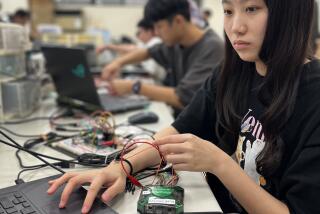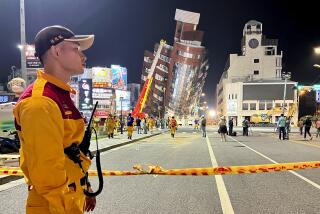Disaster in Japan exposes supply chain flaw
- Share via
Reporting from Shirakawa, Japan; and Beijing — About 40 miles west of the crippled Fukushima nuclear plant, another kind of crisis may be unfolding — this one striking at the heart of the world’s multibillion-dollar market for smartphones, portable music players and other cutting-edge electronics.
The powerful earthquake that rocked Japan last month knocked out a hillside factory owned by Shin-Etsu Chemical Co. Little known outside industry circles, Shin-Etsu is the world’s biggest producer of advanced silicon wafers, a key material needed for the manufacturing of semiconductors. Its Shirakawa plant represented 20% of the globe’s capacity to produce the building blocks on which some key high-technology products depend.
The disaster could prove to be a major concern for chip makers, including Intel Corp. and Toshiba Corp., that buy wafers from Shin-Etsu, analysts said.
But it also has turned the spotlight on a much broader problem in the global economy: Companies around the world often rely on small networks of suppliers that may be thousands of miles away. A good number of those suppliers are in Japan.
Already, quake-related shortages of automotive electronic sensors made by Hitachi’s Automotive Systems business have been blamed for halting or cutting production of vehicles in Germany, Spain, France and Shreveport, La.
The crisis also is expected to slash the supply of some vehicles such as Toyota’s Prius and contribute to higher passenger car prices in the U.S., where temporary worker layoffs already have hit Ford Motor Co., General Motors Corp. and some Japanese auto firms.
Chinese computer maker Lenovo Group was among the latest to warn that a shortage of components from Japan could crimp supplies of finished products, in its case the LePad tablet computer. Another Chinese firm, ZTE Corp., a major producer of cellphones, said it could face shortages of batteries and LCD screens for months.
The likelihood of more disruptions to come has touched off a scramble for alternative suppliers. It has sparked a run-up in the price of memory chips and some parts. And it is almost certain to lead to a rethinking of a global production and logistics system in which a natural disaster in a small part of Japan’s industrial base could have such broad effects around the world.
“There should have been fail-safe measures taken, if one [plant] goes offline it doesn’t throw your whole production schedule off,” said Kenneth Grossberg, a business professor at Waseda University in Tokyo. “How could you make yourself so vulnerable?”
The unusually large concentration of production at a single site such as Shin-Etsu’s Shirakawa campus, he said, may reflect a wider tendency, especially in Japanese society, to centralize operations, whether it’s government or private organizations.
What’s more, the disaster and its aftermath revealed just how far some companies had pushed the just-in-time supply system. The practice, pioneered by Toyota Motor Co., allows companies to reduce inventories, thus freeing up cash for more profitable use elsewhere. But in managing supplies ever so tightly, companies also narrowed their vendors, sometimes to just one or two, leaving little margin for adjusting if something went wrong.
France’s PSA Peugeot-Citroen, for example, usually keeps just a 10-day supply of Hitachi air-flow sensors on hand. With Hitachi controlling more than half of the world’s production of this obscure, $90-retail-priced component, Peugeot and General Motors, among others, had little choice but to cut production when those parts began to flow more slowly.
Just-in-time “is a good plan for normal times, not for emergencies,” said Tetsuji Morino, a managing director at Dai Nippon Printing Co., a $19-billion enterprise based in Tokyo.
He said that only about three of his company’s 50 factories sustained damage. But the actual effect is likely to be bigger as rolling blackouts, transport problems and fuel shortages in Japan hamper production and delivery of supplies for many companies, possibly for months to come.
Koriyama Central Industrial Park in Fukushima prefecture is a case in point. Plants operated in the park by Panasonic Corp., Hitachi, Shin-Etsu and other leading Japanese companies are mostly up and running now, but only at about 50% capacity combined, said Endou Katsuei, executive director of Shinwa Planning Co., which is managing the zone.
He said these factories depend on the delivery of other components, which has been anything but stable. The town’s train station has yet to reopen, roadways have been cracked by the earthquake and many gas stations remain closed, more than three weeks after the disaster.
It’s much the same along the 125-mile stretch of Tohoku Expressway, from Utsunomiya, about 60 miles north of Tokyo, to Sendai, a city in Miyagi prefecture that was ravaged by the tsunami and where many homes remain without gas and hot water.
On the outskirts of Sendai, mangled cars thrown by the massive waves still litter the roads and are jammed against trees and fences, including those outside Sony’s flood-impaired chemical and information devices plant.
Sendai is also home to Tohoku University, one of Japan’s premier institutions and a leading center for semiconductor and related research.
“For some period, we cannot have research activity in some departments,” said Masayoshi Esashi, an engineering professor, describing how the magnitude 9 temblor had damaged three of his research center’s buildings. He was wearing long white boots, and his fingers were bandaged, after days of moving boxes into temporary quarters. “We cannot collaborate with companies because of this problem.”
Esashi also worries about the future of the region’s tech companies. Even if they return to full production soon, he said, they still will probably lose market share — and jobs.
That’s clearly at stake at Shin-Etsu in Shirakawa, about 100 miles north of Tokyo.
Company officials declined to comment beyond their statement Friday that said they’re still assessing the damage. It gave no timetable for when production was likely to restart.
While there’s no visible sign of damage on the buildings’ gray exterior, local residents and business owners said the plant couldn’t have escaped the violent sideways shaking March 11 that they said lasted for three minutes.
In the neighborhood around the plant, the quake knocked down home antennas and roof tiles. In some cases, entire structures collapsed.
“Shin-Etsu had huge damage inside; machines and equipment fell with a crash,” said Toshiaki Ishi, 49, a lifelong resident of the area, as he relayed what friends who work at the plant told him. Employees were asked to stay home.
Making silicon ingots and slicing them into wafers takes weeks and is a precise and delicate process. Analysts said it’s possible that ingot furnaces, typically 12 to 15 feet tall, may have toppled or shaken so hard that ingots dropped inside the machines, breaking internal equipment parts. There also could be issues of poison gas leaks, and persistent aftershocks have complicated the recovery work.
It’s hard to know the extent of Shin-Etsu’s problems and the looming capacity crunch because the company has disclosed little information about the damage and the overall supply situation, said Joel Scheiman, a Tokyo analyst for MF Global Holdings who has followed Japan’s chemical industry for 25 years.
For now, he and other analysts said, there appears to be enough 300-millimeter wafers to go around through May.
Akira Minamikawa, vice president of ISuppli’s Japan research, doesn’t see Shin-Etsu’s Shirakawa plant returning to full strength until October. That means the company will most likely be supplying first-tier customers first, such as Toshiba, Taiwan Semiconductor Manufacturing Co. and Elpida Memory Inc.
Intel spokesman Chuck Malloy wouldn’t comment about Shin-Etsu but said it’s rare for the Santa Clara, Calif.-based chip maker to rely on a single supplier. Given the extent of the disaster in Japan, he said, Intel is in “fairly good shape.”
But that won’t stop wafer material prices from rising, analysts said. Nor will it provide much comfort to smaller users of silicon wafers.
Grace Semiconductor Manufacturing Corp., a foundry in Shanghai with 1,600 employees, has been reassuring its clients that it will be able to deliver the goods, despite the potential supply constraints. But that’s easier said than done.
“Japan is our main vendor,” said Sarah Cheng, a Grace spokeswoman. “Two out of three silicon wafers we use are from Japan.”
Times staff writer Nathan Olivarez-Giles in Los Angeles contributed to this report.
More to Read
Inside the business of entertainment
The Wide Shot brings you news, analysis and insights on everything from streaming wars to production — and what it all means for the future.
You may occasionally receive promotional content from the Los Angeles Times.












